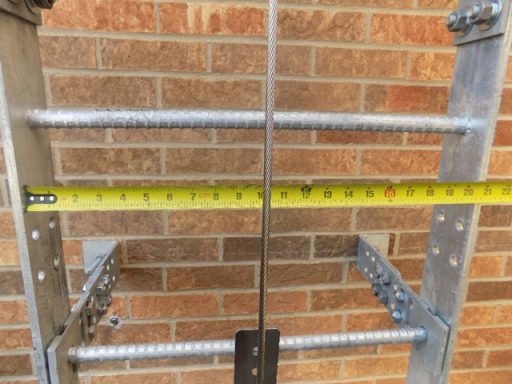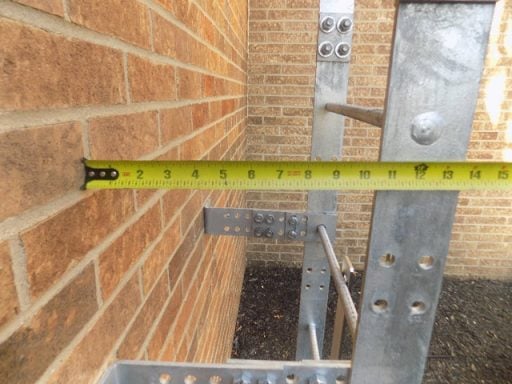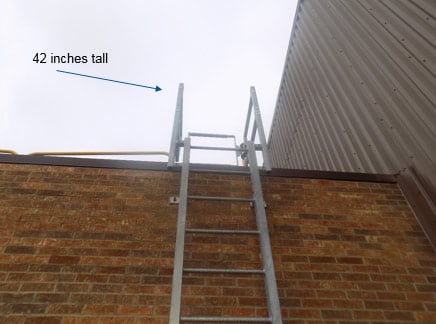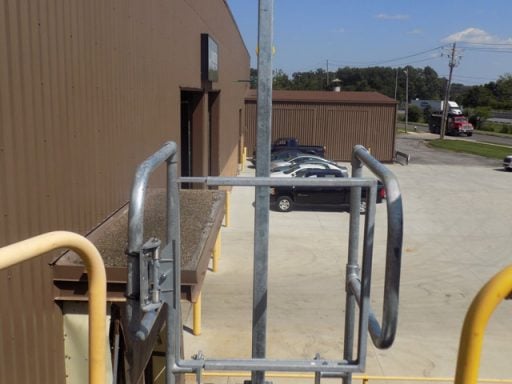
OSHA Safety Ladder Standards: Do You Know These 5 Measurements?
![]() The Occupational Safety and Health Administration's (OSHA) Revised Walking Working Standards requirements for fixed ladders took effect in 2018, but even in 2025 many people aren’t aware how those new standards relate to fixed ladders.
The Occupational Safety and Health Administration's (OSHA) Revised Walking Working Standards requirements for fixed ladders took effect in 2018, but even in 2025 many people aren’t aware how those new standards relate to fixed ladders.
If you missed the change or are looking for a “starter” list of pertinent fixed ladder dimensions to ensure compliance, keep reading, and don’t forget to download our guide to fixed and portable ladders, too.
Below is a quick punch list of five important measurements to check to ensure compliance:
Ladder Height: 24 Feet
The easiest—and most publicized—change has to do with ladders that extend 24 feet or more above a lower level. Ladders that are 24 feet or higher can no longer use “safety cages” as a means of protecting workers. Ladders that were newly installed or altered after November 19, 2018, require a ladder safety system or personal fall arrest system.
2036: Final ladder cage phaseout
For existing fixed or permanently mounted ladders that extend 24 feet above a lower level, OSHA developed a timeline to phase out the use of ladder cages as a means of fall protection. Ladders installed before November 19, 2018, are exempt from the requirement until 2036.
IMPORTANT: Any portion of an existing ladder that is replaced or repaired must be equipped with a ladder safety system or personal fall arrest system
The final deadline for installing a ladder safety system or personal fall arrest system for all ladders is November 18, 2036. Don’t wait until then to update your ladder to meet requirements. Not only is it in the best interest of your employees to have a system that actually prevents falls, but if too many companies wait until the last minute, demand will likely outpace supply—leading to delays, backorders, and potential compliance issues.
Ladder Rung Width: 16 Inches
Per OSHA 1910.23(b)(4), ladder rungs, steps, and cleats must have a minimum clear width of 16 inches (measured before installation of ladder safety systems) for fixed ladders.
Although it’s a current OSHA requirement, our fall protection inspection teams still see ladders that do not meet this minimum standard. Chances are good that you may have heard about the program to do away with the cage, but if you haven’t checked up on your climbing width, it may mean your fixed ladders that extend 24 feet or more above a lower level are still not compliant.
"How wide should my ladder be?" may differ depending on what kind of lifeline system you have on your ladder. For Example, we recommend a wider climbing surface to accommodate a ladder lifeline system and to make the ladder easier to climb. The image below shows Diversified Fall Protection’s EZ Series Roof Access Ladder Systems, which have a 20-inch climbing width.

Ladder Stand-Off Clearance: 7 Inches
Another frequent stumbling block—literally—in passing OSHA compliance is the requirement that the ladder provide at minimum 7 inches of clear distance between the ladder rungs (centerline) and the building. This figure includes any permanent obstructions such as pipes or conduit.
Per OSHA 1910.23(d)(2), the minimum perpendicular distance from the centerline of the steps or rungs, or grab bars, or both, to the nearest permanent object in back of the ladder is 7 inches.
This 7-inch minimum stand-off clearance protects the person climbing the ladder from likely trip hazards that would exist with less free space between the ladder and building.

The new fixed ladder design allows for easy in-field stand-off distance accommodation around obstructions to achieve the required minimum 7-inch clearance.
Access Level Grab Bar Extension: 42 Inches
To protect the worker exiting a ladder, OSHA requires a 42-inch high grab bar extension above the access level or landing platform at the top of the ladder.

Per OSHA 1910.23(d)(4), the side rails of through or sidestep ladders must extend 42 inches above the top of the access level or landing platform served by the ladder.
Access Level Extension Width: 24 Inches
This extension above the access level must be at least 24 inches wide (to accommodate the width of the climber’s body) and not more than 30 inches of clearance, allowing the climber to easily reach both handrails.

Per OSHA 1910.23(d)(5): For through ladders, the steps or rungs are omitted from the extensions, and the side rails are flared to provide not less than 24 inches (61cm) and not more than 30 inches (76 cm) of clearance. When a ladder safety system is provided, the maximum clearance between side rails of the extension must not exceed 36 inches (91 cm).
Ensure Your Ladders Are OSHA Compliant with DFP
In this post we’ve only covered a handful of the key measurements one would need to take in order to verify a fixed ladder’s OSHA compliance. However, the vast majority of the ladders we fail while performing ladder assessments miss the mark on one of the key measurements mentioned above.
For a complete treatment of all of the updated OSHA regulations pertaining to fixed ladder systems, download our Ladder e-Book or contact Diversified Fall Protection to speak with a fall protection expert. We can help you purchase and install a complete OSHA-compliant fixed ladder system.
Schedule an assessment with Diversified Fall Protection
Contact Us to request a fall safety review

b-1.jpg?width=1368&height=1340&name=Rail%20(175)b-1.jpg)

